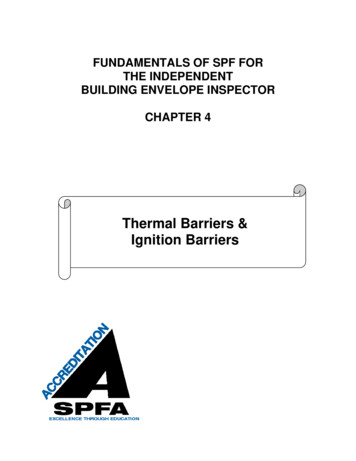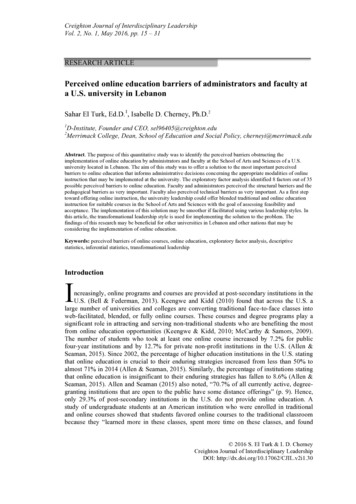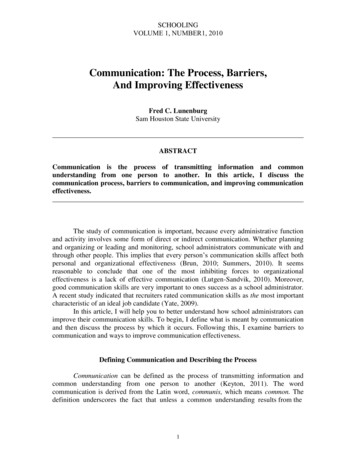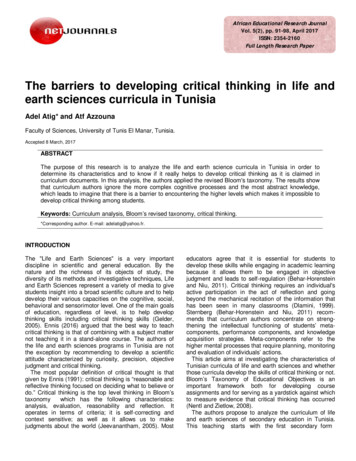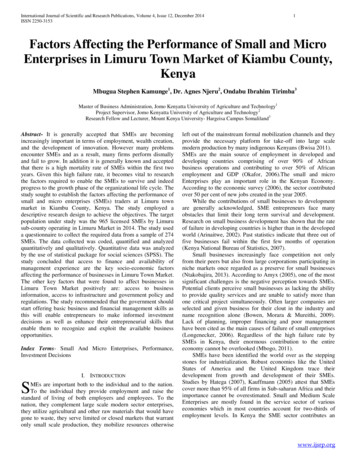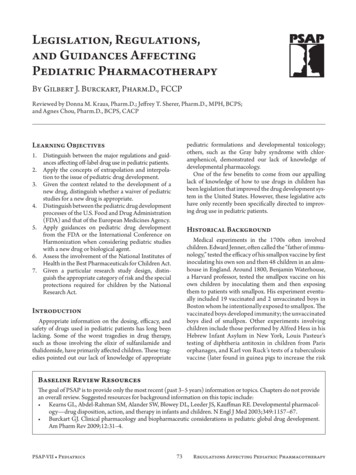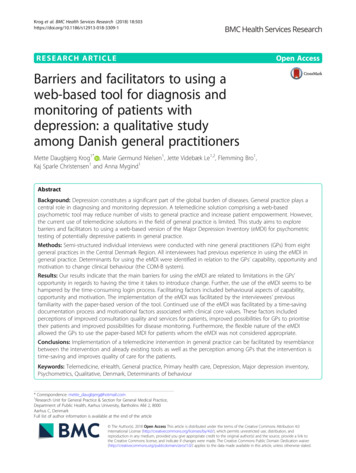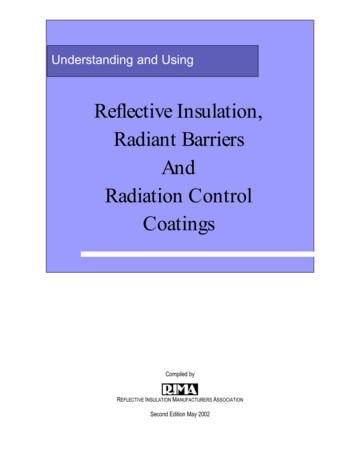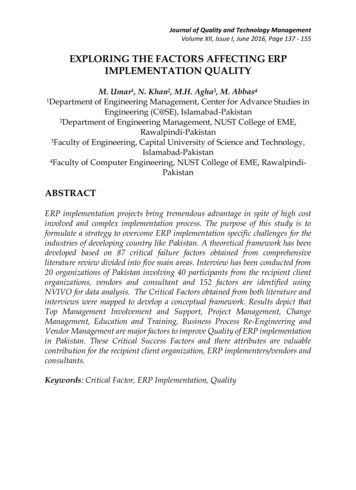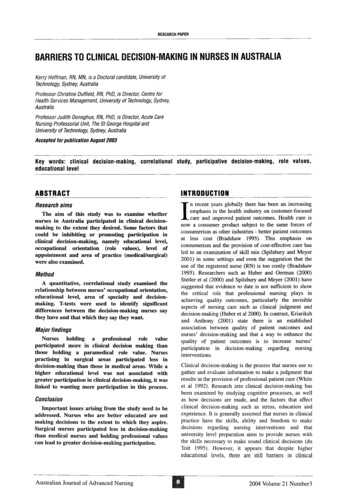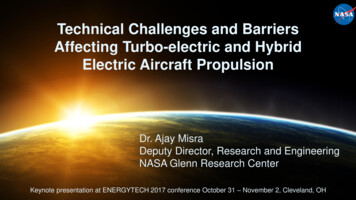
Transcription
Technical Challenges and BarriersAffecting Turbo-electric and HybridElectric Aircraft PropulsionDr. Ajay MisraDeputy Director, Research and EngineeringNASA Glenn Research CenterKeynote presentation at ENERGYTECH 2017 conference October 31 – November 2, Cleveland, OHNASA GRC RESEARCH AND ENGINEERING DIRECTORATE
Why Electric NASA GRC RESEARCH AND ENGINEERING DIRECTORATEImprove fuel efficiencyLower emissionsReduced noiseLow operating costEfficiency of electricalcomponents significantlyhigher than IC engines orgas turbine engines
All Electric AircraftPowerConverterNASA GRC RESEARCH AND ENGINEERING DIRECTORATE3
Battery Capability Required for All Electric Urban Mobility Aircraft2001802–3passengerVTOLRotorcraftRange, Miles160Normal aircraft1402–3passenger1204 passenger8060404 passenger2–3passengerCurrent commercial batterystate-of-the-art: 170 Wh/kg20150 Wh/kgNASA GRC RESEARCH AND ENGINEERING DIRECTORATE300 Wh/kgBattery Specific Energy, Wh/kg (Pack Level)400 Wh/kg4
All Electric Commuter Aircraft900800Range, Miles700Studies by Happerle (German Aerospace Center)Dornier 328 turboprop28 passengersBaseline range – 750 milesSpeed for electric – 140 – 200 mph600500Considering 30 min of reserve400300200100180180360720(Baseline)(Modified aircraft)(Modified aircraft)(Modified aircraft)NASA GRC RESEARCH AND ENGINEERING DIRECTORATEBattery Specific Energy, Wh/kg (Pack Level)5
Series Hybrid Electric erRange ExtenderNASA GRC RESEARCH AND ENGINEERING DIRECTORATEElectricMotor Gas turbine/IC engine used eitherto charge batteries or provideauxiliary power to drive the motor Battery used during takeoff andpart or all of cruise Gas turbine/IC engine usedprimarily during part of cruise Gas turbine/IC engine cancontinuously run at the mostefficient point Gas turbine is sized much smallerChallenge: Efficiency of small enginesrelatively low (on the order of 30% )compared to large gas turbineengines6
Parallel Hybrid Electric AircraftFuelBatteryGasTurbinePowerConverterNASA GRC RESEARCH AND ENGINEERING DIRECTORATEElectricMotor Degree of hybridization can beadjusted depending on themission One option is for gas turbine toalways operate at its peakefficiency point and to usebattery when power required islarger than power delivered bythe gas turbine (e.g., duringtakeoff)Challenge: Increased complexity of themechanical coupling Increase in control complexityas power flow has to beregulated and blended from twopower sources7
Battery Requirement for Commuter and Regional HybridElectric Aircraft48 passenger turbopropRange, Nautical MilesHybrid electric, 70 Passengers(Based on Isikveren et.al., ISABE2015 Paper)1400 For 600 nm, battery pack with specific energygreater than 500 Wh/kg for total energy to beless than conventional propulsionRange for 15% block fuel reduction Battery specific energy must be at least 600Wh/kg for operating fuel/energy cost paritywith advanced conventional propulsion12001000800600Assuming pack specificenergy 60% of cellspecific energy400200300400500600700800900Battery Pack Specific Energy (Wh/kg)NASA GRC RESEARCH AND ENGINEERING DIRECTORATERUAG Dornier – DO228NG (Juretzko) 20 passenger hybrid electric aircraft 335 – 350 miles range with battery specificenergy of 150 Wh/kg8
Single Isle 737-Class AircraftBoeing SUGAR Volt Parallel hybrid, 150 PAX 1-5 MW, 3-5 kW/kg, 93%efficient electric machines 60% efficiency improvementover 2005 baseline aircraft if arenewable grid is assumedBattery requirement: 750 Wh/kgLent (UTRC): Single aisle 737 class, geared turbofan Electric motor used during takeoffalong with gas turbine engine Addition of turbogeneartor duringtakeoff more effective Batteries greater than 1000 Wh/kgrequired to be competitive withturbogeneratorNASA GRC RESEARCH AND ENGINEERING DIRECTORATEPompet et.al. (Germany): Single aisle 180 passengers, 3300 nmiles base line 13 % block fuel reduction for 1500Wh/kg battery pack 6% block fuel reduction for 1000Wh/kg battery pack May not be any benefit for batterypack with less than 1000 Wh/kgspecific energySingle-aisle 737 class hybrid electricaircraft will require 1000 Wh/kg or higherbattery specific energy9
Hybrid Electric Helicopters400Light UtilityMulti MissionBaseline (no electric)350Hybrid – 290 Wh/kgRange, Miles300Hybrid – 523 Wh/kg25020015010050Medium Utility0Light Utility(Sikorsky S300 C)NASA GRC RESEARCH AND ENGINEERING DIRECTORATEMulti-Mission(Bell 206 L4)Medium Utility(Airbus EC175)10
Battery Chemistry PossibilitiesNASA GRC RESEARCH AND ENGINEERING DIRECTORATE11
Reduction in Cell-to-Pack Battery Specific EnergySpecific Energy (Wh/kg)Typically40 – 50 %decreaseBatteryPackNASA GRC RESEARCH AND ENGINEERING DIRECTORATEReduction in Specific EnergyFrom Cell to Pack: Thermal management Battery managementsystem Safety features PackingCell12
Limits on Useable Specific Energy800Based on current packaging and integration technologiesUseable Energy Density (Wh/L)700Mg-ion600500Li-O2400Tesla Model S300200Li-NMC622Li-SGr-NMC622100Nissan Leaf00NASA GRC RESEARCH AND ENGINEERING DIRECTORATE100J. Electrochem. Soc., 162 (6), A982 (2015),Energy Environ. Sci.,2014, 7, 1555-1563200300400Useable Specific Energy (Wh/kg)50060013
Notional Progression of Battery Capability 500 Wh/kg,Li – oxygen, Beyond Li chemistries400 – 500 Wh/kg300 – 400 Wh/kg300 – 350 Wh/kgLi metal anode, advanced cathodeSi anode, advanced cathode5 YearsNASA GRC RESEARCH AND ENGINEERING DIRECTORATELi metal anode, sulfur cathode10 YearsSOA – 250 Wh/kg atcell level15 Years14
Projected Advances in Battery TechnologyRate of increase in specific energy is typically on the order of 5 – 8% per yearSpecific energy loss from cell to pack is typically 50 to 60%Assuming 8% increase per year at cell levelSpecific Energy (Wh/kg)80015 % loss from cell topack (current)700Innovation required in: New chemistries andmaterials for cells600500Cell40030032 % loss from cell topack200 Pack design andintegration10001718 1920 21 22 232017NASA GRC RESEARCH AND ENGINEERING DIRECTORATEYear242526 27282930203015
Dependency of Evolution of Electrified Aircraft on Battery Advances2-3passenger ,200 milesToday150-170Wh/kg20 passenger300 miles2-3 passengerVTOL, 100miles30 passenger300 miles4 passengerVTOL, 60miles4 passengerVTOL, 100120 miles20212025300Wh/kg400Wh/kg20 – 30passenger 400 miles(?)NASA GRC RESEARCH AND ENGINEERING DIRECTORATE2028500Wh/kgNotional timeline based on optimisticprojectionsMore system analysis required to identifyrequirementsAll Electric?600Wh/kg800700Wh/kg Wh/kg70 passenger 800miles (15% blockfuel reduction)Light utilityhelicopter?203070 passenger1000 miles(15% blockfuel reduction)?Timeline1000Wh/kgSingle aisle737 classHybrid Electric16
Multifunctional Structures With Energy Storage CapabilityBatteryPackElectricmotorReplace battery withmultifunctionalstructural elementBatteries with some load bearing capability or structure with energy storage capability ?NASA GRC RESEARCH AND ENGINEERING DIRECTORATE17
Application of Fuel CellsX-57 FUELEAP SystemUsing Solid Oxide Fuel Cell:Power output: 120kW(161hp) max continuous,158kW (209hp) peak Specific power: 314 W/kg(0.19 hp/lb) Efficiency: 62% (10k ft, stdday)Solid oxide fuel cells High efficiency Low power density at system level Potential range extender for small hybrid electric aircraft Durability, thermal cyclingPEM fuel cell: Needs hydrogenNASA GRC RESEARCH AND ENGINEERING DIRECTORATE18
Turboelectric AircraftBenefits of Turboelectric Propulsion: Enables new aircraft configurations Decoupling of speeds of turbine and fan Multiple fans can be driven by one gasturbine, providing high propulsiveefficiency due to higher bypass ratio(BPR) Can enable boundary layer ingestioncapabilityNASA GRC RESEARCH AND ENGINEERING DIRECTORATEChallenge: Developmentof distortiontolerant fanBoundary Layer Ingestion Testing atNASA GRC19
Advanced Single Aisle Turboelectric ConceptSingle-aisle Turboelectric Aircraft with Aft BoundaryLayer Ingestion (STARC – ABL) Conventional single aisle tube-and-wing configuration Twin underwing mounted turbine engines withattached generators on fan shaft Ducted, electrically driven, boundary layer ingestingtailcone propulsor Projected 7 – 12 % fuel burn savings for 1300 nmmissionNASA GRC RESEARCH AND ENGINEERING DIRECTORATE20
Distributed Electric Propulsion Dozen, small electric motors thataccelerate airflow over the wing –provides more lift at low speed –enables takeoff in normal runway Cruise – two electrically drivenpropellers mounted on tip of each wingX – 57: Distributed Electric Propulsion Demonstrator9-Passenger ConceptNASA GRC RESEARCH AND ENGINEERING DIRECTORATE 9 passenger plane, battery powered withturbine range extender Much more efficient, cost effective and quietthan comparable aircraft Increase use of small and medium USairports and decrease emissions21
Propulsion-Aircraft Integration for Electrified AircraftNeed analytical tools to assess benefits of propulsion airframe integration onelectrified propulsion aircraft configurationsNASA GRC RESEARCH AND ENGINEERING DIRECTORATE22
High Power Density Electric Motors1614Power Density, kW/kg12Large gas turbine engineNASA research (power density atelectromagnetic level), 1 – 3 MW, 96 % efficiency10864Various claims (100 –200 kW)Siemens (200 kW)System level, 95 %efficiency2Current electric vehiclesKey Technologies for IncreasingPower Density: Higher conductivity materials Insulation materials with high thermalconductivity Better magnetic materials Better packing density Advanced topology Thermal management Lightweight structures High speed operationCurrent industrialNASA GRC RESEARCH AND ENGINEERING DIRECTORATE23
High Power Density Power Converters High power density power converters needed Need 2-3X increase in power density of MWscale converters Goal: 19 kW/kg plus 99 % efficiency with noncryogenic cooling 26 kW/kg plus 99 % efficiency withcryogenic cooling Approach – Wide bandgap semiconductors(SiC and GaN)NASA GRC RESEARCH AND ENGINEERING DIRECTORATEAdvanced magnetic materials to handlethe higher switching speeds afforded bynew SiC and GaN semiconductors.24
Large Turboelectric Aircraft With Superconducting MotorsLarge Aircraft with Superconducting MotorCu statorcoilsCurrent research: Development of fullysuperconducting, MW scale motorSuperconductorrotor coilsHigh ac losses major challenge forsuperconducting statorPower densities greater than 20 kW/kg achievableNASA GRC RESEARCH AND ENGINEERING DIRECTORATE25
Thermal Management Challenges For a 5 -10 MW system, 100s of kW heat generated Heat from multiple sources – power electronics, motors, batteries Integration of heat rejection from multiple sources Low grade heat difficult to handle Increasing use of composites lowers the heat rejection capability of the system Lightweight and compact thermal management system required Integrated thermal management approach at the aircraft level requiredNASA GRC RESEARCH AND ENGINEERING DIRECTORATE26
Power Transmission Transmission of MWs of power will requirelarge diameter Cu with severe weight penalty High voltages (on the order of 2000 V or more)will be required for the current generation ofpower cables (Cu, Al)– Advanced insulation materials required– Thermal management of the power cable system New materials with higher electricalconductivity than Cu required– Carbon nanotubes show promise– Superconducting materials possibility – will requirecryogenic cooling of transmission cablesNASA GRC RESEARCH AND ENGINEERING DIRECTORATE27
Development of Integrated System Integration of multiple componentsand optimization of performance ofintegrated system a challenge– Optimum power extraction fromturbine– Coupling of generator, motor, and fan– Optimized energy managementNASA ElectricAircraft Testbed(NEAT) for testingmulti MW levelpower system Control system with energycoming from multiple sources Integrated testing required toaddress system and sub-systemlevel integration challengesNASA GRC RESEARCH AND ENGINEERING DIRECTORATE28
Notional Progression of Electrified AircraftIncreasingrange 4-passenger allelectric urbancommuter9-10 passengercommuter allelectric andhybrid electricrange extenderToday 4-seater allelectric urbancommuting9-10 seater allelectric andhybrid electricrange extender20-30 passengercommuter hybridelectric aircraft50 passengerregional hybridelectric aircraftwith limitedrange5 Years Large aircraft withsuperconductingmotors and hydrogenfuel ?20-30 passengercommuter allelectric aircraft50 -100passengerregional hybridelectric aircraftwith full rangeIncreasingrange10 Years15 Years20 Years Turboelectric single aisle withinnovative architectureNASA GRC RESEARCH AND ENGINEERING DIRECTORATE29
Concluding Thoughts Electrified Aircraft is a reality – NOT “IF”, IT IS “WHEN” Progression of all electric and hybrid electric aircraft is a strong function of advances inbattery technology Turboelectric aircraft with innovative propulsion architecture and integrated airframepropulsion system is an attractive option for large single aisle aircraft Advances in many component technologies required– 3 to 5 times increase in power density of electric motors– 3X increase in power density of power converters– 3 - 5X decrease in weight of power cables for MW level power transmission Integration of technologies and demonstration of integrated technologiesat sub-system and system level are requiredNASA GRC RESEARCH AND ENGINEERING DIRECTORATE30
large diameter Cu with severe weight penalty High voltages (on the order of 2000 V or more) will be required for the current generation of power cables (Cu, Al) – Advanced insulation materials required – Thermal management of the power cable system New materials with
